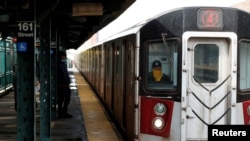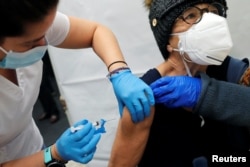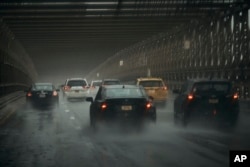On February 19, Wall Street Silver, an X influencer with 1.2 million followers, posted a side-by-side video comparison showing a flooded subway labeled "USA" next to a futuristic video of a metro station marked "China."
Wall Street Silver's post reads:
"Left: Subway in New York, USA Right: Subway in Guangzhou, China
But don't worry... U.S. politicians have it under control. They will send Ukraine and Israel billions more while giving illegal migrants free health care. That should do the trick!"
Nearly 85,000 users shared, liked and commented on the post, which had received more than 9.4 million views at the time of this writing.
The post is misleading on many levels, and the comparison is unfair.
To begin with, it is not true that the New York City subway budget directly depends on the funds the U.S. government "will send to Ukraine and Israel" or on providing free emergency health care to immigrants.
Secondly, the China-labeled footage does not show the subway system in Guangzhou. The station featured in the video is Shenzhen's Metro Line 14, finished in 2022. That is comparing a two-year-old construction with the more than a century-old New York Subway system, opened in 1904.
Thirdly, the side-by-side videos present an apples-to-oranges comparison. One shows the New York City subway system's worst day of flooding (September 29, 2023) caused by heavy rainfall, while the other shows the Shenzhen Metro's brand-new Line 14.
A fair comparison would show how Chinese subway systems cope with a weather event similar to the one shown in the New York footage. In 2021, flooding in Zhengzhou, the capital of China's central Henan province, left 14 people dead in a flooded subway, reportedly due to authorities' mishandling of the disaster.
More on each of the three claims below.
The New York subway budget; Ukraine and Israel; and immigrants' health care
Let us start with the "free health care" for "illegal immigrants" claim.
New York City provides free emergency and prenatal health care to all residents regardless of their legal status.
Here is an explanation from advocacy group INCLUDENYC: "New York State federal law assures that everyone — regardless of legal status, with or without medical insurance, with or without the ability to pay — has the right to emergency medical services in hospitals. Undocumented immigrants are eligible for Medicaid only for the treatment of emergency medical conditions or prenatal care."
Also, "Pregnant women in NYC do not need to show any documentation regarding their immigration status in order to receive prenatal care," it explained.
All other health care is conditional and depends on the legal status, employment, income and many other factors detailed in the fact sheet compiled by the New York City administration.
Now, to the subway budget. The Metropolitan Transportation Authority, or MTA, manages and operates the New York City subway system.
The MTA's funding does not come from the federal government but has a special status between the New York City and New York state budgets, it requires a multilevel review and approval, including by the public.
The MTA budget is heavily dependent on the fare — the price passengers pay for using the system. Before the COVID-19 pandemic, the system was serving almost 3 billion passengers annually. The pandemic dramatically reduced that statistic for the subway — by 91% in 2020 compared with 2019. MTA expects its ridership to never return to pre-pandemic levels, and in 2023, its revenue from fares was $4.6 billion — significantly less than the pre-pandemic annual of more than $6 billion.
Yet, the MTA's five-year development program includes the investment of some $40 billion into NYC's subways and buses.
More importantly in the context of this fact check, the U.S. government gave the New York MTA a $14 billion grant as part of the COVID relief bill adopted in 2021.
As for the U.S. federal government funding for Ukraine and Israel, the assistance is indeed unprecedented. Yet it is also important to understand that the funding includes military equipment, communication tools, training, humanitarian aid, grants and other types of aid.
Even combined, the U.S. aid to the two countries is not close to the government's domestic spending.
For example, Israel, historically the biggest recipient of U.S. financial support, has received about $300 billion from the U.S. since its founding in 1948.
The U.S. aid package to Ukraine has reached some $75 billion since the beginning of Russia's full-scale invasion in February 2022.
For comparison, the U.S. authorized the Treasury to spend $700 billion in 2008 to help American homeowners, businesses and financial institutions overcome the economic crisis.
Century apart
The New York City subway is one of the world's oldest public transit systems: its trains began operating on October 27, 1904. It's also one of the biggest rapid transit systems in the world, with 472 stations, most of which were built before 1940.
The system has operated around the clock year-round for most of its history.
By comparison, the subway featured in the China video footage shows a station on Line 14, an express rapid transit line in the city of Shenzhen, a leading global technology hub often called China's Silicon Valley.
Construction of Line 14 began in 2018. The line opened on October 28, 2022.
Built before 1940, the New York City Subway stations featured in the video are around 100 years older than Shenzhen's metro lines.
The flood and response
The two videos in the viral X post seem selected to show the worst of the New York City metro and the best of China's.
The New York subway station was flooded on September 29, 2023, when the remains of Tropical Storm Ophelia dropped heavy rainfall on the New York City metropolitan area.
New York Governor Kathy Hochul declared a state of emergency for New York City ahead of the weather event, and the state's National Guard was deployed to assist in the response. The flooding caused major disruptions to New York City's subway system with some lines suspended. However, there were no reports of serious harm to people or deaths in the subway flooding.
A fair comparison would be how China's subway systems fared during similar weather events and how government officials responded.
One recent example occurred in the provincial capital of Zhengzhou in China's central Henan province on July 20, 2021, when record-breaking rainfall flooded the city's subway tunnels, leaving passengers trapped in rising waters.
Fourteen people lost their lives in the flooded subway tunnels, a tragedy that was "preventable," according to Sixth Tone, a Shanghai-based, English-language, state-owned online magazine.
Sixth Tone reported that Zhengzhou received just under 62 centimeters of rain between 8 p.m. on July 17 and 8 p.m. on July 20, 2021. That's nearly an entire year's worth of rainfall.
Zhengzhou's weather bureau issued five storm red alerts in the 24 hours before the disaster, which should have triggered a citywide shutdown of all unnecessary outdoor activities. "Yet the warning failed to catch the city's attention," Sixth Tone reported.
The subway operator began closing some station entrances at 3:40 p.m. on July 20 but did not order a full suspension until 6:10 p.m. that day. Sixth Tone quoted several survivors as saying that "floodwater started flowing into the carriages around 6 p.m."
Other state media outlets reported rescue efforts by the People's Liberation Army, while local authorities set up barriers, reportedly to prevent people from laying wreaths for those who drowned and block those already placed from public view.
In January 2022, Chinese authorities released the results of an investigation that concluded the Zhengzhou government had "failed to take the primary responsibility in flood prevention and disaster relief, and seriously lacked risk awareness regarding extreme-weather disasters."
The investigators concluded that authorities in Zhengzhou also "concealed or delayed the reporting of those killed and missing in the disaster," as reported by the official Xinhua News Agency.









